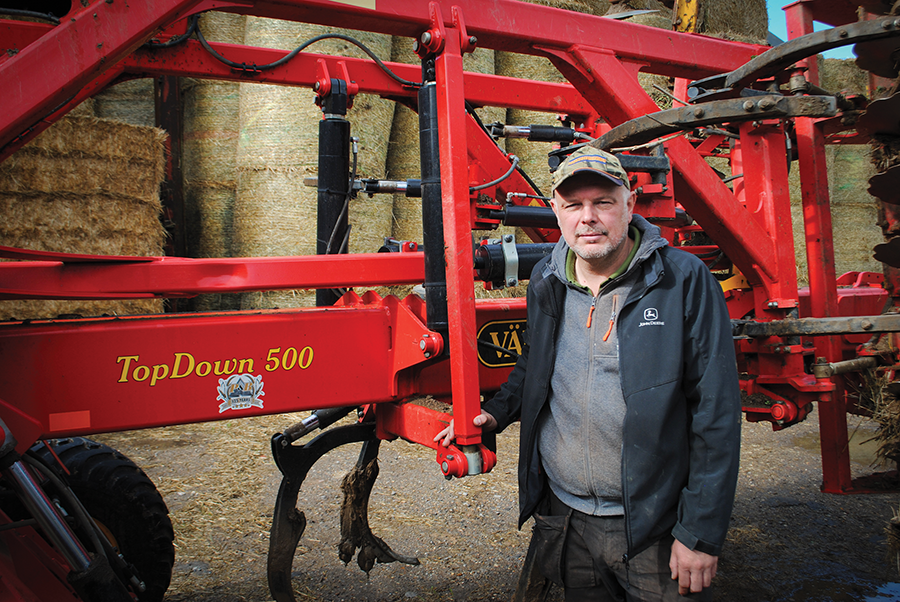Plough plays second fiddle to more flexible cultivator
9th January 2024
Rising production costs coupled with pressure on cultivation timeliness and labour availability, have led Lincolnshire arable farmer Tim Horner of Holme Farm, Tetney to review the use of his plough as a key cultivator in favour of a more flexible and faster disc/tined-based cultivation system, without compromising yield and quality.

Mr Horner operates a mixed farm enterprise with 485ha of medium to heavy clay soils supporting arable crops including wheat, barley, spring barley, oilseed rape, spring oats and beans. Cereals are grown for feed and average yields are 10t/ha.
For many years, the plough has been the primary cultivator, which has been used successfully to keep on top of black-grass and facilitate the over wintering of mostly heavy and challenging soils.
Black-grass is managed but is an on-going problem says Mr Horner, so the introduction of spring crops alongside herbicides and a change in cultural practices has helped keep the problem under control.
“We use cultivations to move the soil and keep it aerated,” he says. “We are not advocates of the strip tillage approach to crop establishment because it can create cloddy seedbeds. Our plough is now only used on about 40% of the fields each year, while the majority goes under the TopDown.
“Our land is best cultivated early and left to weather for at least six weeks,” he explains. “All our straw is baled and sold to livestock farmers and some is kept for bedding down our own cattle herd.”
Well-built machines
The TopDown is designed to slice up the entire soil surface, mix in harvest residues and loosen to depth, all in a single pass using Vaderstad’s System Disc in front, followed by tines at 27cm spacing for good mixing and to provide a level surface finish. Then the packer offers consolidation, which can be very important on heavier soils, especially when wet.
Mr Horner always aims to plough the spring cropped land as early in the autumn as possible, leaving it open to help drainage over the winter period when it often rains. Average annual rainfall is 585mm.
Ideally, ploughed land is then cultivated with the farm’s Vaderstad Rexius Twin to create a suitable seedbed for the 6m Rapid drill in the spring. The Rexius is a very well-built machine, like all kit that is made by Vaderstad, he says.
Land prepped for winter crops is subsoiled to remove compaction if necessary and is cultivated with the TopDown. Depending on the seedbed quality, fields are cultivated with the Rexius Twin but if further cultivation is not necessary, then it is straight in with the Rapid drill.
The oilseed rape land is cultivated in August with the TopDown and drilled with wheat in October.
“Direct drilling doesn’t work as a whole on this farm and I’m not convinced that it would be the right approach for us,” explains Mr Horner. “It would be great to sell all the cultivation kit, but it just isn’t feasible. We drill oilseed rape straight into stubbles with the sub-soiler and a Stocks applicator.”
“Nothing comes close”
“We also tried several other cultivators to compare against the TopDown, but nothing really comes close to it for mixing trash and working at different levels. I like its versatility too, so we can use it like a Carrier, or the packer can be lifted out of work to produce soils with an open finish.
“Our TopDown works shallow and deep, but generally we work down to about six inches. For shallow work at depths of about one inch, we just use the discs,” he explains.
“Our TopDown is fitted with hard wearing and durable tungsten tipped Marathon points on the tines, which means that they retain the working angle even as they wear, which is ideal in wet soils. We only changed our original points last year despite employing the TopDown over 900ha in three seasons. This is our first TopDown, which is now five years old. Wing shares, 50mm and 80mm points are also available in optional Marathon versions, where they are reinforced with a wearing surface of hard metal (tungsten carbide) for substantially longer life which reduces the downtime.”
Machinery portfolio:
- 7 furrow plough
- 5m TopDown
- 6.2m Rexius Twin
- 6m Rapid Drill
- Flatliner subsoiler
- Power harrow
- 4.25m Simba discs.
Read more machinery articles here
